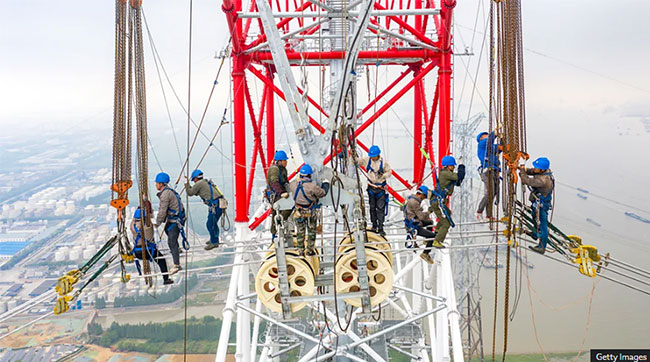China’s Ultra-High-Voltage Grid: ‘Bullet Train for Power’
China leads the world in clean energy production and is now deploying an ambitious ultra-high-voltage (UHV) electricity grid. Dubbed the “bullet train for power,” this initiative aims to transmit energy efficiently over long distances. But will this bold strategy prove successful?
Fengxian Converter Station: A Critical Node
In a quiet village near Shanghai, the Fengxian Converter Station stands as a testament to China’s energy ambitions. This hub receives electricity generated 1,900 km (1,200 miles) away at the Xiangjiaba Hydropower Station in southwestern China. The power travels through one of China’s earliest UHV transmission lines, a technology that has since revolutionized the nation’s energy infrastructure.
The Xiangjiaba-Shanghai link, operational since 2010, marked the beginning of China’s UHV era. It was built to channel electricity from remote hydro and coal power stations to bustling cities, addressing the nation’s power shortages and supporting economic growth. Today, this UHV network is integral to distributing energy from China’s wind and solar farms, which are predominantly located in distant regions.
The Science Behind UHV Transmission
UHV technology operates on the principle that higher voltage means lower current, reducing energy loss during transmission. This efficiency enables electricity to travel vast distances while minimizing waste.
China defines UHV as transmission lines carrying direct current (DC) at 800 kilovolts (kV) or more and alternating current (AC) at 1,000 kV or more. DC lines are optimal for long distances, while AC lines, though shorter, can integrate more flexibly with local grids.
The Birth of China’s UHV Grid
In the early 2000s, China grappled with frequent power shortages, largely due to the mismatch between resource-rich regions and densely populated areas. Liu Zhenya, then head of China’s State Grid, envisioned a nationwide UHV network to resolve blackouts and establish China as a leader in transmission technology. Despite initial opposition over concerns about cost, reliability, and environmental impact, UHV technology became a cornerstone of China’s energy policy in 2006, aligning with national development goals.
The first UHV project, linking Shanxi and Hubei provinces, began in 2006. By 2010, the Xiangjiaba-Shanghai line became the world’s longest and most powerful transmission system, capable of meeting up to 40% of Shanghai’s energy needs. As of April 2024, China had 38 operational UHV lines spanning 48,000 km (30,000 miles).
Accelerating Renewable Energy
While initially designed for hydro and coal power, UHV lines are now pivotal in transmitting wind and solar energy. China’s desert-based renewable energy projects, such as the Ningxia-Hunan line, exemplify this shift. These lines support China’s proposal for a global power grid, aiming to connect energy systems worldwide to facilitate large-scale clean energy use.
UHV transmission offers unique advantages in a vast country like China. It compensates for the variability of renewable energy by transferring power from regions with favorable weather conditions to those without. However, only 56.2% of UHV-transmitted electricity in 2022 came from renewables, with most sourced from hydropower.
Challenges and Limitations
Despite its advantages, UHV technology faces significant challenges:
- High Costs: China has invested over 1.6 trillion yuan ($222 billion) in UHV projects. These lines often rely on coal power to maintain consistent operations when renewable energy is unavailable.
- Local Power Access Issues: Some regions cannot utilize locally generated electricity due to UHV lines prioritizing long-distance transmission.
- Future Shifts: Coastal provinces are increasingly investing in nuclear and offshore wind power, potentially reducing reliance on imported electricity via UHV lines.
Global Impact and Alternatives
China’s UHV model has inspired countries like Brazil and India to adopt similar strategies. However, regulatory hurdles and cost-sharing complexities limit its global proliferation. Large grids also pose risks of mass blackouts, as seen in the 2003 North American outage.
Alternatives like microgrids, which localize energy generation and consumption, are gaining traction in developing nations due to their flexibility and affordability. Experts suggest a balanced approach, combining UHV transmission with decentralized solutions, for a sustainable energy future.
Conclusion
China’s UHV grid demonstrates the potential of high-voltage transmission in enabling a large-scale energy transition. While the technology has challenges, it remains a vital component of the global push toward renewable energy. By integrating UHV with localized systems, countries can create resilient, efficient, and sustainable energy infrastructures for the future.
This article was rewritten by JournosNews.com based on verified reporting from trusted sources. The content has been independently reviewed, fact-checked, and edited for accuracy, neutrality, tone, and global readability in accordance with Google News and AdSense standards.
All opinions, quotes, or statements from contributors, experts, or sourced organizations do not necessarily reflect the views of JournosNews.com. JournosNews.com maintains full editorial independence from any external funders, sponsors, or organizations.
Stay informed with JournosNews.com — your trusted source for verified global reporting and in-depth analysis. Follow us on Google News, BlueSky, and X for real-time updates.














